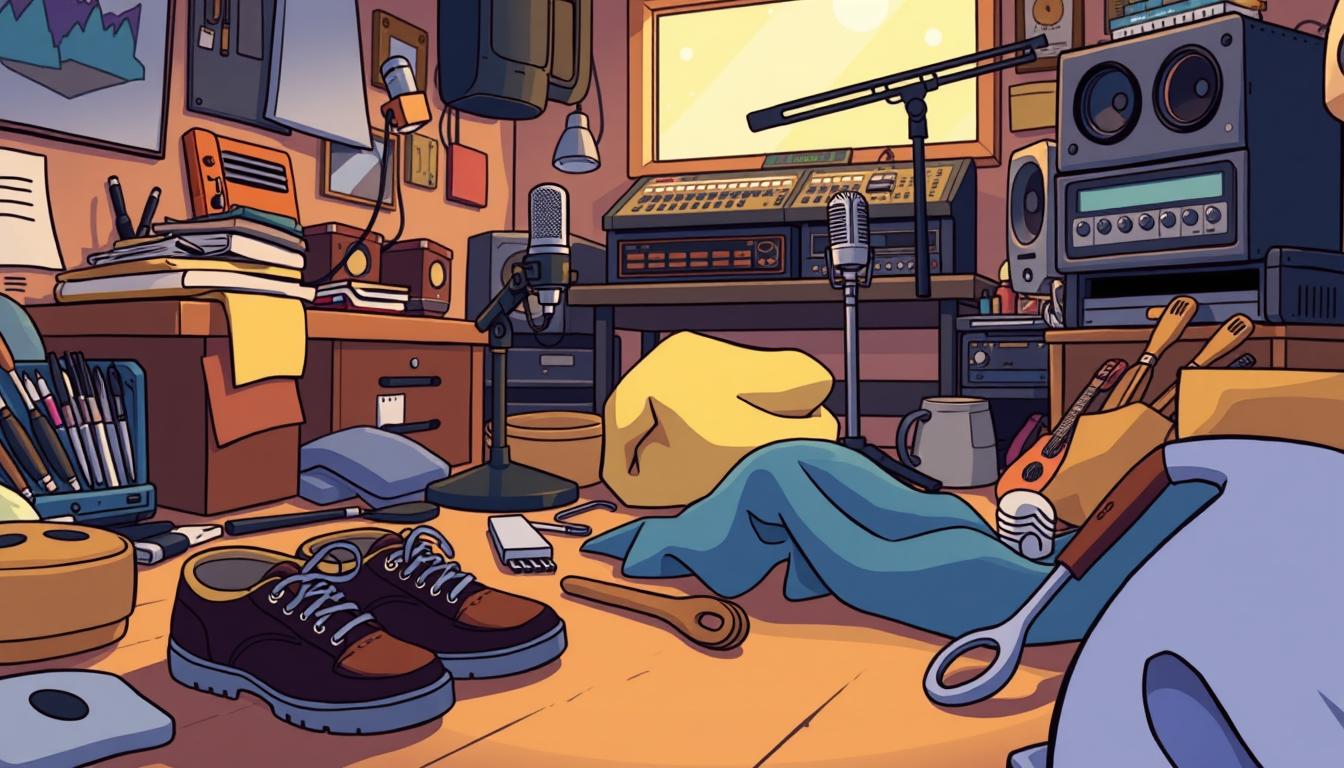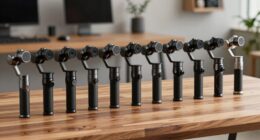Imagine you’re in a dark theater, eyes glued to the bright screen. You’re taken to another realm, not just by visuals but by sounds. The rustling leaves, soft steps, and distant roars engage you. This magic comes from Foley artists. If creating these sounds excites you, you’re in the perfect spot. This guide introduces you to Foley, a key part of film sound. It’s your first step into a creative career full of highs and lows. By learning the basics, you begin a thrilling journey.
Key Takeaways
- Foley artistry adds depth to movie and TV storytelling.
- Foley Artists typically make about $450 for an 8-hour workday.
- Union Foley Artists might get $400-450 daily, whereas non-union artists could make around $200.
- Success in this field often means juggling various projects.
- Editing in Foley is just as important as recording for impacting viewers.
- Knowing the technical bits of Foley work can really boost sound quality.
Understanding the Role of a Foley Artist
A Foley artist is key in movie and TV post-production. They recreate sound effects. This Foley artist job description includes making and recording sounds that boost the audience’s experience. They use live methods instead of pre-recorded sound libraries. Foley artists use props and techniques for real-sounding audio. This audio matches the action seen on screen.
Foley artists use many tools, from daily items to specially made tools. They capture sounds for different scenes. Sounds like footsteps, clothing rustles, and even big events like fights are recreated. This process takes creativity and skill. Each sound must make the story feel real.
Foley artists work closely with sound editors. This team effort makes sure the sound fits the visuals and enhances the story. Editing Foley material often takes as long as it was recorded. This means a day of recording can lead to a day or more of editing. This careful editing helps sound effects blend smoothly.
| Foley Sound Creation Process | |
|---|---|
| Stage | Activities |
| Recording | Utilizing various props to record live sounds |
| Editing | Refining and adjusting sounds for precise alignment with visuals |
| Collaboration | Working closely with sound editors to ensure cohesion |
| Review | Final checks for quality and impact on the audience’s experience |
Foley artists add to scenes in ways often unseen. Yet, their work helps viewers dive into the movie’s world. Their mix of sound design and skill is vital in today’s films.
The Importance of Foley in Film and Television
Foley sound adds depth and realism to movies and TV shows. Named after Jack Foley, it makes scenes feel true to life. Sounds like footsteps and rustling clothes help tell the story better.
Foley is also key in voice acting. It keeps characters’ actions sounding vibrant and real. Movies like The Lord of the Rings and Toy Story show how important sound is. The right sound at the right time makes everything more impactful.
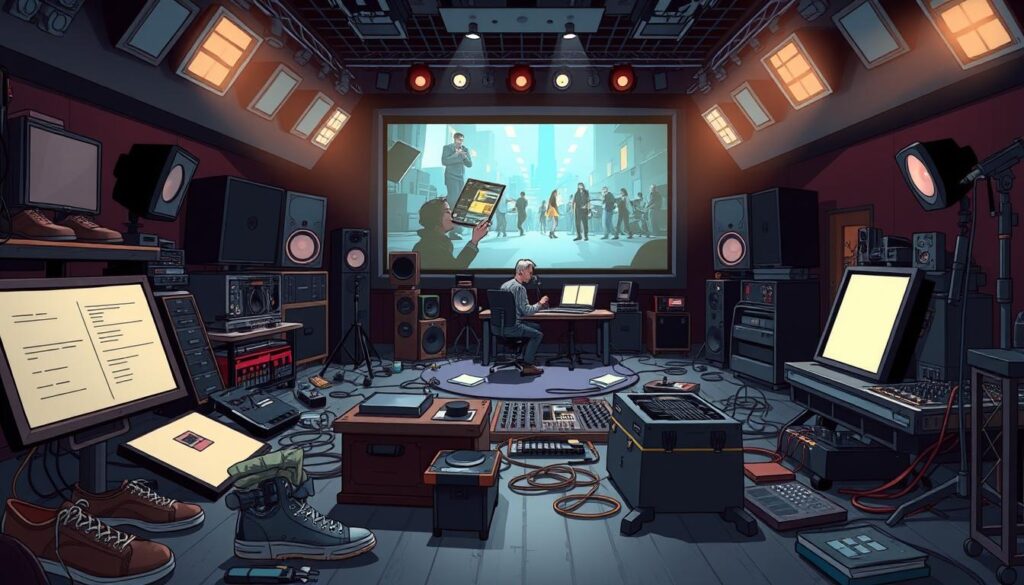
To make Foley sounds, artists use props and body movements. High-quality mics and software are important too. Recording good sound effects takes skill and the right tools.
One common mistake is using too many sounds. It’s also important to match the timing of sounds with the action. Learning from resources like “The Art of Foley” or YouTube can help improve skills. Understanding Foley’s role can deepen your appreciation for film sound.
Skills Required for a Successful Foley Career
To become a great Foley artist, you need many skills. These skills mix technical know-how and creative flair. Starting with a strong base in Foley skills is key. Important qualities include:
- Creativity in Foley helps you invent unique sounds. These sounds make stories come alive.
- Being detail-oriented is important. This makes sure every sound fits perfectly with what’s seen on screen.
- Inventiveness is key for making unusual sounds. Think of the sounds from mythical creatures or exciting chases.
- Good teamwork skills help you work well with directors and sound teams. Together, you create amazing soundscapes.
Foley artists recreate sounds that make movies feel real. Sounds like footsteps and ambient noise are their focus. They often work with tight deadlines and must be quick. This is why being disciplined and responsible is crucial.
Working well with others is must-have. You’ll work closely with the film team and actors. You’ll use props and surfaces to make sounds. Paying attention to how you make these sounds is key.
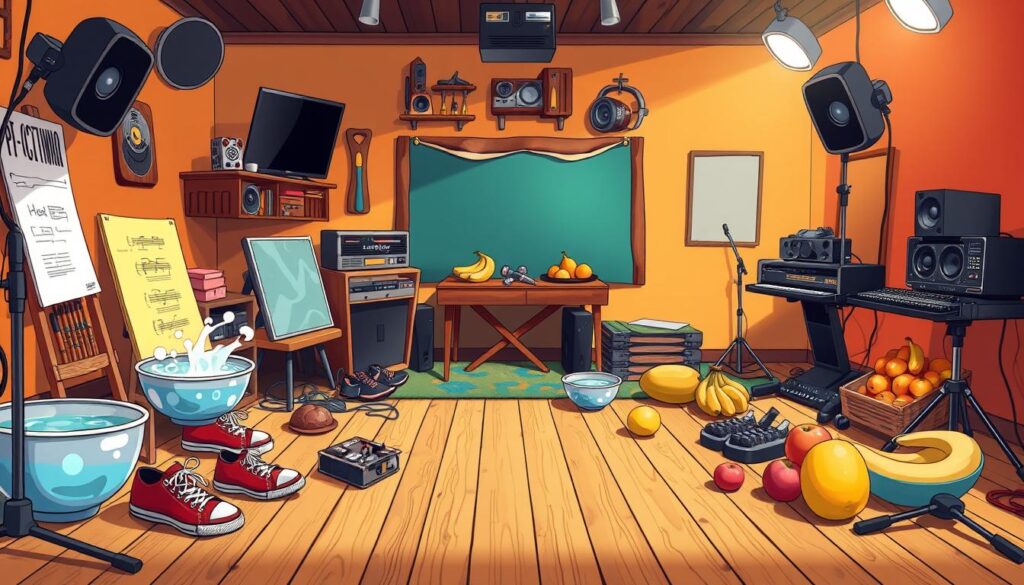
Having a portfolio is a smart move. It should show off your Foley skills and creativity. Networking in the industry is also important. It can open doors to many jobs in audio post-production. While degrees are helpful, showing off your talent is usually more important.
A Beginner’s Guide to Starting a Career in Foley
Starting a career in Foley is thrilling. It’s full of creativity and technical puzzles. Knowing the steps to become a Foley artist will guide you. Each phase is key to growing your skills in this absorbing area.
Key Steps to Enter the Field
To get into Foley, consider these steps:
- Learn the Basics: Get to know sound production. Focus on sound’s role in visual stories.
- Seek Entry-Level Opportunities: Hunt for starter jobs in sound effects or design teams. This helps you learn the ropes.
- Engage in Volunteer Work: Use your skills on indie films or community projects. It’s a great way to see Foley in action.
- Internships: Look for internships. They let you watch pros like Foley Artists. You’ll learn lots this way.
- Network: Make industry friends. Go to events, join film groups, and meet sound designers. Learning from them is priceless.
- Continuing Education: Think about studying sound design more. Formal courses can boost your knowledge and skills.
As you follow these steps to become a Foley artist, stay passionate. Every bit of experience helps you grow. This lets you flourish in this artistic field.
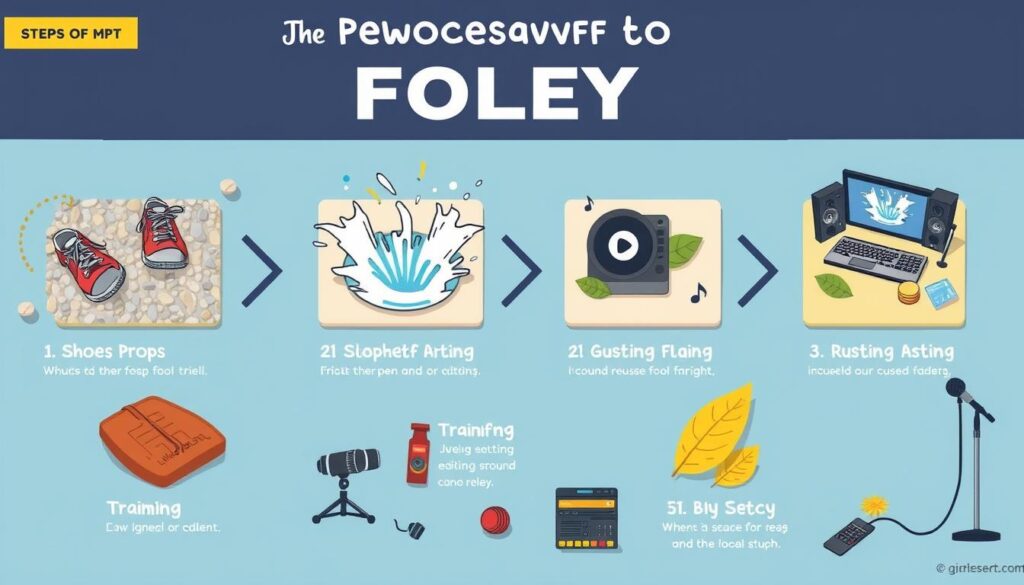
Education and Training Opportunities
Pursuing formal education can make a big difference if you want to be a Foley artist. Foley education programs help you learn more about sound design. You also get to practice in a real setting. Film schools offer experiences that blend theory with practical work. This mix gives a well-rounded education.
Film Schools and Sound Programs
Look for film schools and sound programs with a strong audio production curriculum. These programs cover:
- Sound design basics
- Hands-on work on Foley stages
- Team projects with students and the community
- Using professional tools like Pro Tools and Logic Pro
Online courses on platforms like Udemy and Coursera let you learn at your own pace. Podcasts like The Tonebenders Podcast and Twenty Thousand Hertz share tips from pros. Joining online communities keeps you up to date and inspired.
Jobs in sound design include Sound Designer, Foley Artist, Composer, and Audio Engineer. Each job needs specific skills. Film school can help you develop these skills.
| Resource Type | Examples |
|---|---|
| Film Schools | USC School of Cinematic Arts, NYU Tisch School of the Arts |
| Online Courses | Udemy, Coursera |
| Digital Audio Workstations | Pro Tools, Logic Pro, Ableton Live |
| Sample Libraries | Spitfire Sound, Native Instruments, Output |
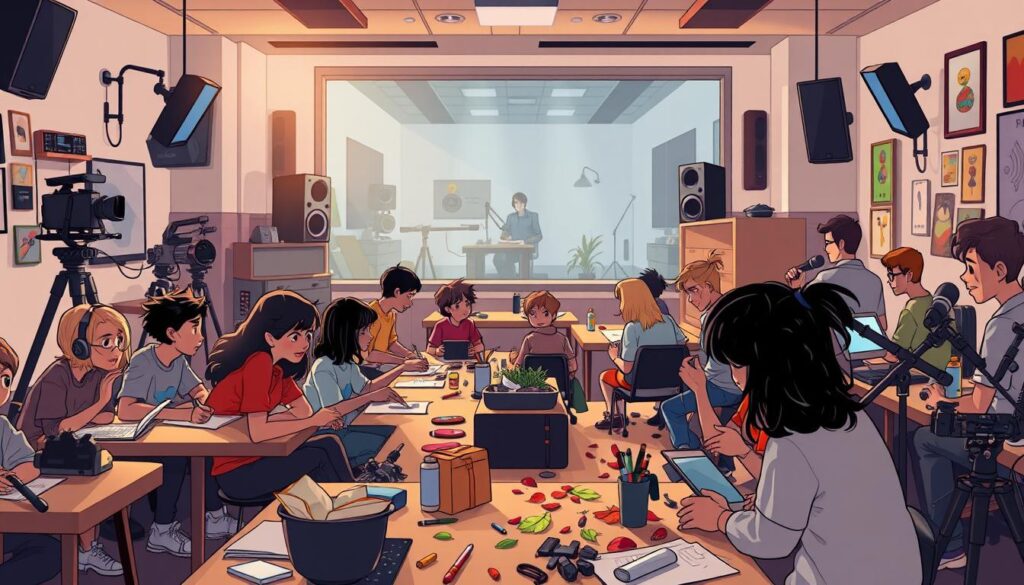
Networking and Building Professional Relationships
In the competitive world of Foley, networking in Foley is key for career growth. Building professional relationships opens doors to new job chances, mentorships, and team-ups. You should start by going to film festivals and workshops. Here, you’ll meet experienced pros face-to-face. Connecting with people in your field can make lasting sound industry connections.
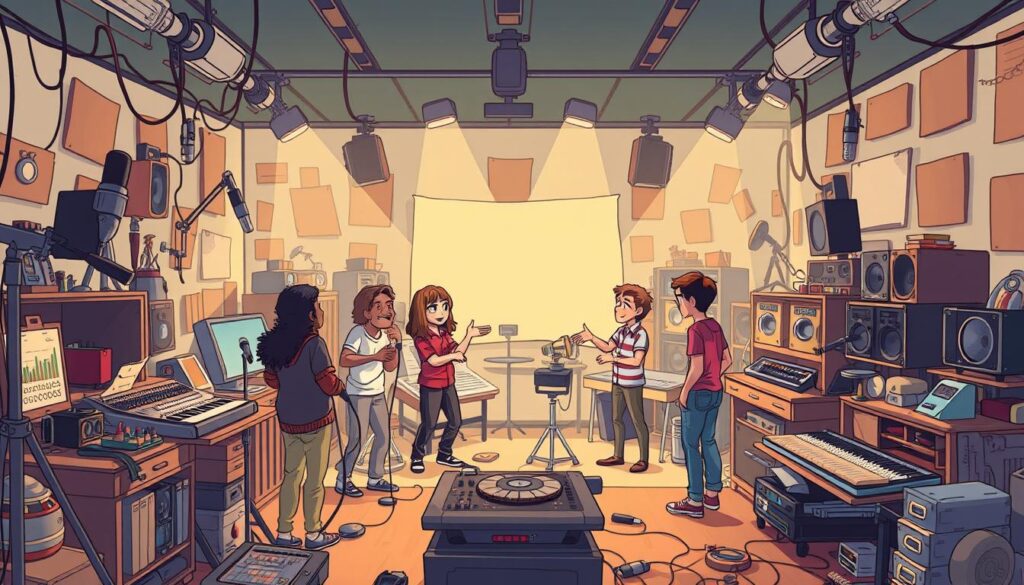
Being part of groups in sound design and Foley is helpful. These organizations give you resources and support from a community of peers. Also, use online networks like LinkedIn to meet leaders in your field. And keep your profile current. Recruiters look online for candidates, so having a sharp online presence is vital.
- Participate actively in career fairs to meet potential employers.
- Utilize your existing networks, such as program coordinators and alumni, for job leads.
- Create an engaging elevator pitch to introduce yourself and your skills effectively.
- Practice elegant social media etiquette to maintain a professional image.
Many Foley artists say their success comes from strong professional bonds. Such connections lead to more work and deeply affect your career’s direction. To keep these relationships strong, keep in touch and value collaborations. This approach can pave the way for a successful career in Foley.
Gaining Experience Through Internships and Entry-Level Positions
Gaining practical experience is crucial for a successful career in Foley. Engaging in Foley internships offers aspiring artists a chance to dive deep into sound production. This hands-on experience helps you polish your skills besides working with pros. This is key to becoming great at the craft.
Volunteer Work and Apprenticeships
Volunteering or apprenticeships also provide valuable sound production experience. Many sound facilities look for newcomers eager to help in various roles, starting from the ground up. Common positions include:
- Production Assistant (PA): A role that provides a basic understanding of the industry by supporting daily operations.
- Intern: Interns do tasks like PAs, sometimes for school credit, instead of pay.
- Assistant: This job involves giving technical help to engineers and mixers.
- Sound Editor: Involves editing dialogue, sound design, and doing Foley tasks.
- Engineer: Focuses on recording voice-overs, ADR, and Foley tasks.
- Sound Supervisor: Manages sound processes and schedules for smooth post-production.
- Re-recording Mixer: Mixes different audio parts to create a unified sound.
Entry-level positions in sound emphasize the importance of starting low to build trust. Employers value candidates who show strong work ethics and passion for sound. Recommendations and networking are vital for securing these jobs. Studios prefer hiring those ready to start at the bottom. They appreciate the commitment to learning sound production deeply.
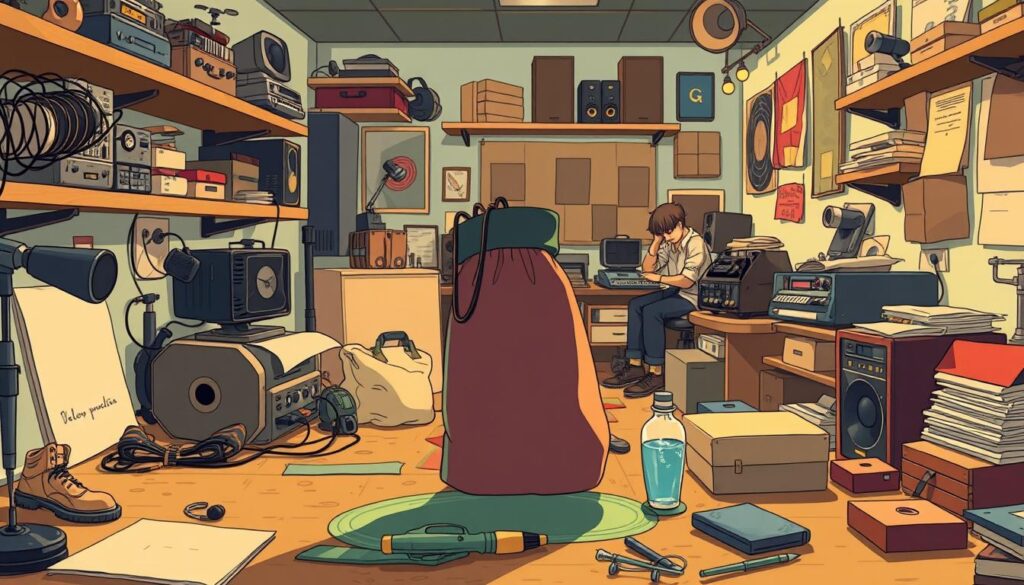
The Technical Side of Foley Production
Grasping the technical side of Foley Production is essential for those aspiring to excel. Knowing about Foley stages—the special areas to create sound effects—is crucial for quality audio. It’s important to be familiar with the equipment used in sound production.
Understanding Foley Stages and Equipment
Foley stages are key to crafting the rich sounds in movies and TV. Each stage has gear for recording sounds like cloth, footsteps, and other props. When working, keep in mind these points:
- Tracks for Cloth Recording: Aim for one track, but up to four can work well.
- Diverse Clothing Options: Use about 20 different clothes in the Foley studio and refresh them as needed.
- Microphone Distance: Keep microphones 1 to 1.5 meters away for cloth sounds, and up to 3 meters for certain textures.
- Recording Duration: Expect to spend around twelve hours on cloth tracks for TV shows, more for complex projects.
- Microphone Types: Shotgun mics are good for recording cloth, especially in studios without perfect acoustics.
The editing part of Foley takes longer than recording. The Foley editor plays a big role in ensuring everything sounds right. Key parts of editing are:
- Syncing the start and stops of moves accurately.
- Keeping internal phases aligned.
- Fixing any issues with cloth sounds and removing unwanted noises.
- Dealing with low-frequency rumbles and other stage noises.
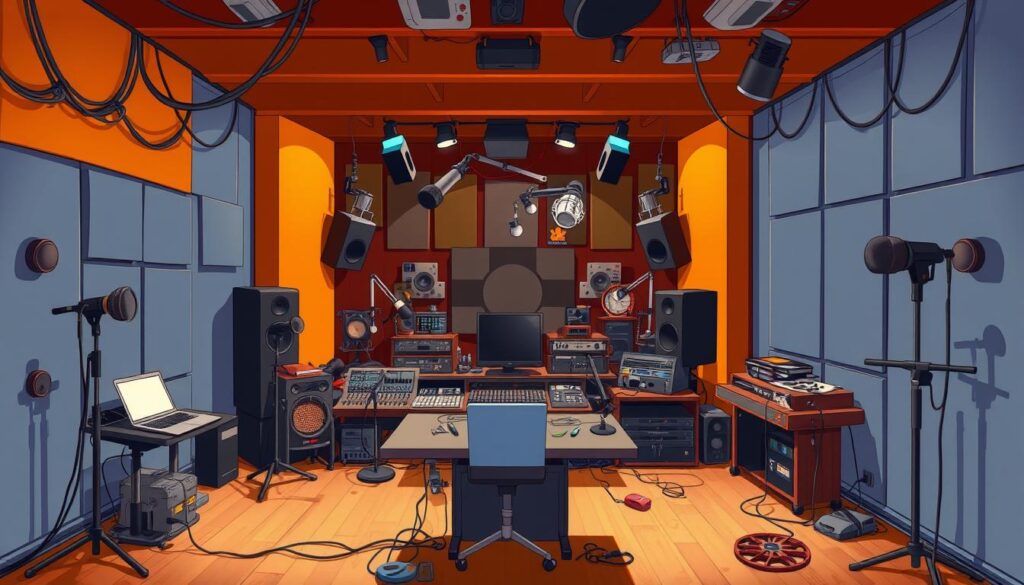
Learning the technical aspects of Foley and mastering production equipment will up your audio game. Knowing your tools and environment boosts your work’s quality, opening up creative possibilities.
Tips for Aspiring Foley Artists
Starting your journey as a Foley artist is both exciting and rewarding. Here are some tips to help you succeed and improve your skills. These will also boost your chances in your Foley career.
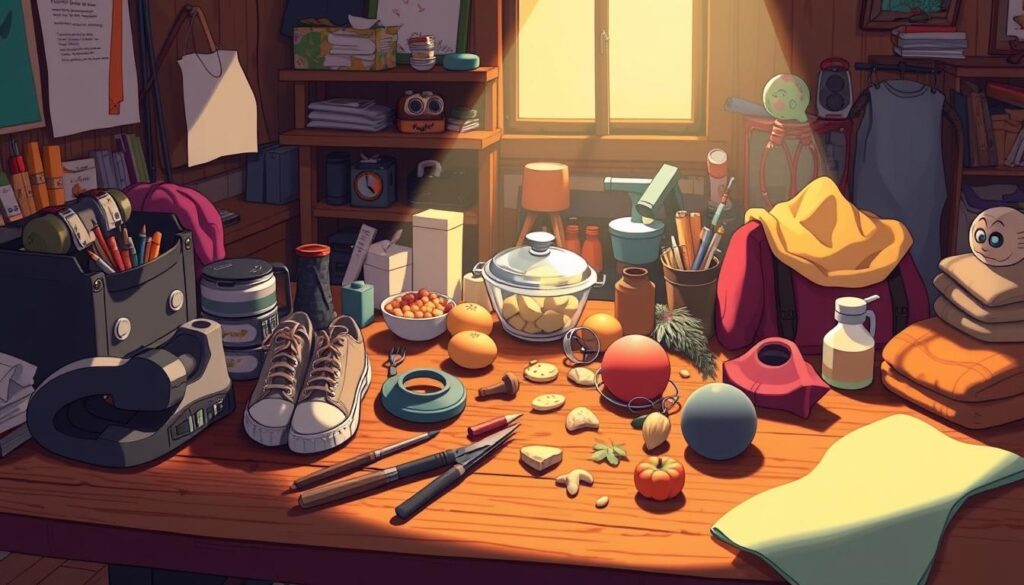
Practice is key. Try out different materials to make unique sounds. You’d be surprised at the sounds everyday items can make when you’re creative.
- Develop your artistic style: Being unique can help you stand out. Add your personal touch to sounds for fresh results.
- Build a diverse portfolio: Show your creativity and technical skills. A great portfolio is important for nabbing future work.
- Network effectively: Meeting other professionals can lead to new chances. Go to events, join forums, and take workshops.
- Utilize technology: Learn to use sound software like Pro Tools, Logic Pro, or Adobe Audition. It can improve your Foley work.
- Seek practical experience: Try internships or volunteer work for real-world practice. It builds a strong career foundation.
To wrap up, following these Foley artist tips will help you on your sound design path. Keep learning and stay adaptable as you grow in your career.
Understanding the Salary and Job Market for Foley Artists
The world of Foley artists offers various pay scales. Typically, union jobs pay between $400 to $450 per day. In contrast, non-union jobs pay about $200 per day. This shows a gap in earnings. This gap is due to different factors like the type of project, experience, and union status.
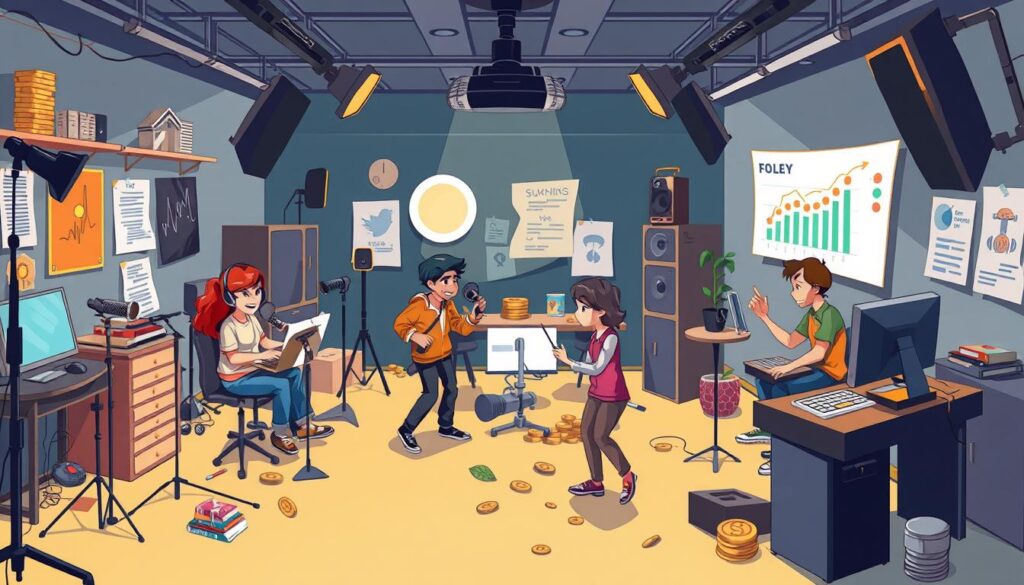
Becoming a Foley artist means entering a tough field. Many experienced artists have strong ties in the industry. This makes it hard for new people to break in. Newcomers often have to work on many projects to earn enough. Their yearly pay depends on these projects.
“Foley artists rely not only on their skills but also on the ability to foster connections within the industry.”
Having an education in sound or music helps a lot. It makes you more employable as a Foley artist. Making connections and gaining experience through internships are key. Working in various types of media, like streaming, has its own opportunities despite often lower pay.
| Experience Level | Daily Rate (Union) | Daily Rate (Non-Union) |
|---|---|---|
| Entry-Level | $200 | $200 |
| Mid-Level (5+ years) | $400-$450 | $200 |
| Highly Experienced | $450+ | N/A |
For a Foley artist, being able to communicate is crucial. It helps in working with sound teams and networking. Creativity and patience help in creating unique sounds. This highlights the creativity needed in Foley work. Understanding the salary and market conditions helps aspiring artists succeed.
Conclusion
As you start your career in Foley, know that it’s all about passion and skill. This guide has taught you how important technical abilities, creativity, and working together are in sound design. You’ve discovered key methods to make your Foley work stand out, like syncing sounds just right and editing footsteps smartly.
Joining the sound design world takes more than just knowing your stuff. It’s about being eager and devoted. Working well with others and staying disciplined will help you grow. Finding new techniques and sharpening your skills will keep you excited about your work. As you dive into Foley, make sure to connect with others in the field. Working together can open up amazing chances and lead to great ideas.
Never forget, staying persistent is key to making it in this creative career. Always meet deadlines and keep talking to your team. If you’re ready to work hard and keep learning, you’ll move forward in your Foley career. You’ll truly make your mark in the world of sound design.

